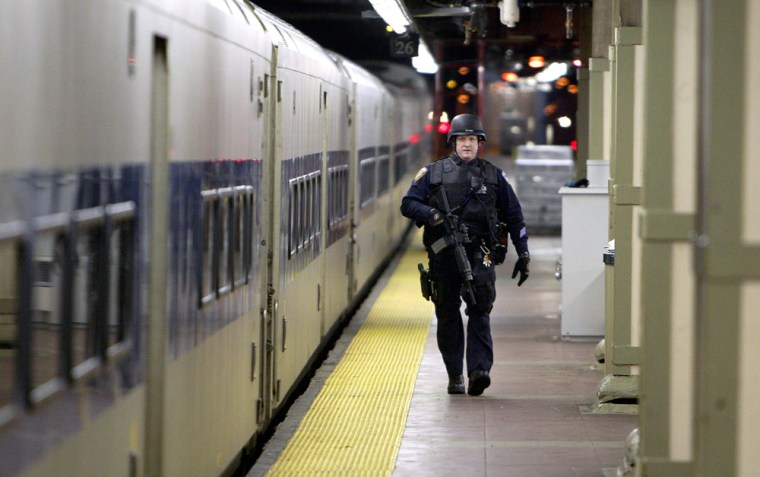The U.S. urban transportation system remains vulnerable to an attack similar to that which rocked London Thursday morning, according to homeland security experts.
“It’s about as vulnerable as it always has been,” said Juliette Kayyem, a terrorism expert at Harvard University. What has been done, she added, is “pretty piecemeal — not part of any comprehensive effort.”
Homeland security experts say that improving commuter rail security is difficult and expensive due to the very nature of the rail systems. And absent any terrorist attack in the United States in over three years, there is little public pressure on Congress to come up with solutions.
“People are willing to put up with inconvenience every time they board an aircraft,” said Francois Boo, a terrorism expert with GlobalSecurity.org. “But if you required the same procedures every time you board a subway, every day, just to go a couple of stops, that’s different.”
Daunting challenge
Securing America’s commuter rail lines is a daunting task. Unlike airports, where passengers arrive an hour before their flight and can be funneled through security devices, rail systems have multiple entrances at each of what may be hundreds of separate rail or subway stops. And at rush hour, it’s not uncommon for thousands of commuters to be boarding several trains at once in busy hub stations such as Grand Central or Union Station in Washington.
“We cannot apply the same approaches to security in public transit that you do in aviation, because of the sheer volumes of people,” said Greg Hull, director of operations safety and security for the American Public Transportation Assoc., which represents the nation’s commuter rail and bus lines.
Rail security officials insist some progress has been made, much of it invisible to commuters, including promising new technologies using inexpensive RFID (radio frequency identification) tags and “smart” closed-circuit cameras.
Most subway and bus drivers now have two-way radios to allow them to communicate with their home base, for example, while communications systems have been upgraded to help transit workers talk directly to police and emergency rescue personnel. Transit employees, from bus drivers to custodians, are being trained to be vigilant and report suspicious behavior to supervisors. And the number of uniformed and plainclothes security officials has been increased.
New technologies, meantime, are helping improve security on the rail lines themselves and in rail yards, where trains are maintained overnight. RFID tags, for example, can be read by sensors at a distance. Embedding them in employee badges allows security guards to keep track of personnel in a busy railyard at night, and quickly focus on people who had no tags. “So you could say that guy doesn’t have the right badge or the right profile, so why is he walking around that train,” said Ken Barney, a security expert at computer giant EDS.
Surveillance upgrade
“Smart” surveillance cameras may also help security guards, who are often overwhelmed by the sheer number of cameras they are supposed to monitor. Virginia-based ObjectVideo for example, is installing software to help rail officials in Madrid and Barcelona monitor their high-speed rail line. “They have more than 700 cameras and only five or six people to watch them,” said Carlos Angeles, managing director for ObjectVideo in Europe. “That’s 100 cameras per person.”
ObjectVideo’s software makes that task easier by analyzing what the camera sees according to a set of rules, based on an object’s size, location and movement, and if it fits a predetermined profile, sends an alarm to draw the attention of a guard.
But all of these security improvements, from better training to more guards to sophisticated electronic monitors, cost money, and commuter rail systems — public agencies with tight budgets — have little cash to spare. Commuter rail officials complain that the U.S. Department of Homeland Security has focused on making airlines safer, but has spent far less money on commuter rail lines — some $15 billion for airlines vs. only $115 million for rail security, though as many as 16 times more people ride rail lines than airplanes.
A recent study by the American Public Transportation Association estimated that rail systems need some $6 billion for security improvements. “There’s pretty much agreement on the things to put in place — more cameras, more sensors, more perimeter protection, improving survivability after an event,” said Harvard homeland security expert Daniel Prieto. But even addressing only the most pressing needs, “We’re talking billions of dollars,” he said. “That is an order of magnitude greater than is being spent.”
Ultimately, however, the lack of money to improve commuter rail security may reflect the public’s interest — or lack of it.
“We as a nation have made a choice that to make our commuter rails secure would require too much disruption of our everyday lives,” said Harvard’s Kayyem, who also is an analyst with MSNBC. “Until there is an attack here, it’s just the nature of this that you don’t respond. We always respond to the last attack.”
